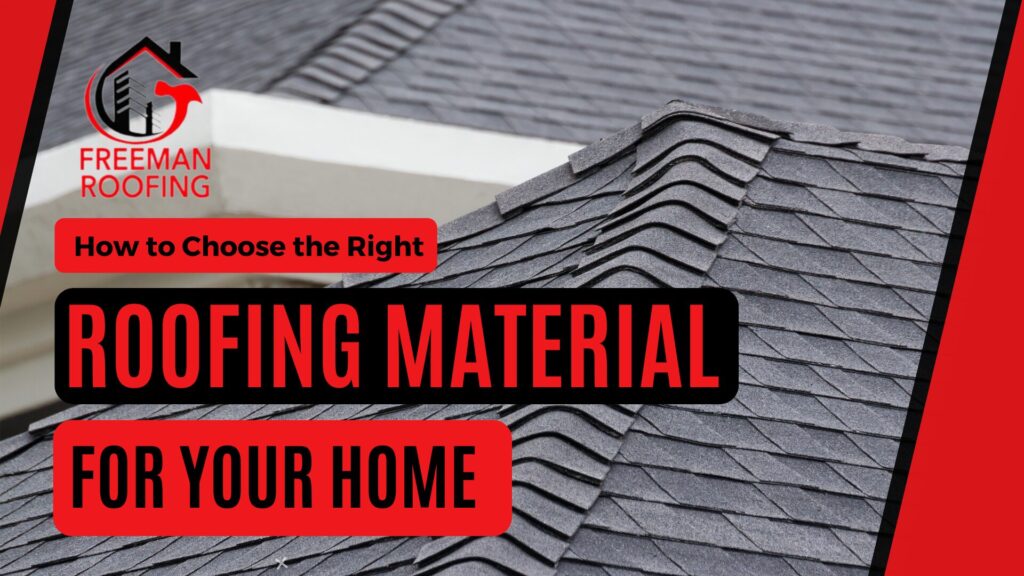How to Choose the Right Roofing Material for Your Home

Choosing the right roofing material for your home is a critical decision that can affect your home’s appearance, protection, and long-term maintenance costs. With a variety of materials available, each offering unique benefits, it can be overwhelming to know where to start. This guide will walk you through the key factors to consider when selecting the perfect roofing material for your home.
1. Consider Your Home’s Architecture and Style
Why It Matters
The style of your home plays a big role in determining which roofing material will complement its design. A roofing material that matches your home’s architectural style not only enhances curb appeal but also adds to the overall aesthetic harmony.
What to Look For
- Traditional Homes: Asphalt shingles or slate roofing offer a classic, timeless look.
- Modern Homes: Metal roofs or flat roofing materials can complement sleek, minimalist designs.
- Colonial or Mediterranean Homes: Clay or concrete tiles provide a warm, textured look suited for these styles.
2. Climate and Weather Conditions
Why It Matters
Different roofing materials perform better in certain climates. Your region’s weather can impact the longevity and effectiveness of your roof. For example, areas with heavy rain or snow may require a different material than places with hot, dry climates.
What to Look For
- Cold Climates: Asphalt shingles and metal roofing are excellent choices for colder climates because they shed snow and ice efficiently.
- Hot and Humid Climates: Clay tiles or metal roofs are ideal for hot climates, as they reflect heat and reduce cooling costs.
- Rain-Prone Areas: Metal roofs and slate are great choices for areas with heavy rain, as they are durable and water-resistant.
3. Durability and Longevity

Why It Matters
The lifespan of your roofing material is a crucial factor in your decision. While some materials require frequent maintenance or replacements, others can last for decades with minimal upkeep.
What to Look For
- Asphalt Shingles: Typically last 15-30 years and are a cost-effective option.
- Metal Roofing: Can last 40-70 years with proper maintenance, depending on the material (steel, aluminum, copper).
- Slate and Tile Roofing: These materials can last over 100 years, making them a long-term investment.
- Wood Shingles: Typically last around 30-40 years but may require more upkeep to prevent moss and mildew buildup.
4. Budget Considerations
Why It Matters
Roofing materials vary significantly in price, so it’s important to find a material that fits within your budget while still meeting your needs for durability and aesthetic appeal.
What to Look For
- Cost-Effective Options: Asphalt shingles are the most affordable option and work well for homeowners on a budget.
- Mid-Range Options: Metal roofing and wood shingles provide a good balance of durability and affordability.
- Premium Options: Slate, clay, and concrete tiles can be expensive upfront, but their longevity and aesthetic appeal make them worth the investment.
5. Maintenance Requirements
Why It Matters
Some roofing materials require more maintenance than others. It’s important to consider how much time and effort you’re willing to put into maintaining your roof.
What to Look For
- Low-Maintenance Options: Metal roofing, asphalt shingles, and slate are relatively low-maintenance materials that require little upkeep.
- High-Maintenance Options: Wood shingles require more attention, as they are prone to moss and mildew buildup, while tile roofs may need periodic repairs.
6. Energy Efficiency

Why It Matters
Energy-efficient roofing materials can help reduce your home’s energy consumption, keeping it cooler in the summer and warmer in the winter. This can result in lower utility bills and a more comfortable living environment.
What to Look For
- Reflective Materials: Metal roofing and clay tiles are energy-efficient because they reflect heat from the sun, keeping your home cooler.
- Insulating Materials: Wood shingles and slate have natural insulating properties, helping maintain your home’s interior temperature.
- Cool Roofs: Some roofing materials, like reflective asphalt shingles, are specifically designed to reflect more sunlight, reducing heat absorption and lowering energy costs.
7. Environmental Impact
Why It Matters
As environmental concerns grow, many homeowners are considering the ecological footprint of their roofing materials. Some materials are more sustainable than others, offering better energy efficiency and recyclability.
What to Look For
- Eco-Friendly Materials: Metal roofing is 100% recyclable, and clay or concrete tiles have a long lifespan, reducing the need for replacement.
- Sustainable Options: Wood shingles made from responsibly sourced materials or recycled materials like rubber and plastic can help reduce your home’s environmental impact.
Bottom Line
Choosing the right roofing material involves considering a variety of factors, from climate and durability to style and budget. By evaluating your needs and the benefits of each material, you can make an informed decision that ensures your roof performs well for years to come. Whether you’re replacing an old roof or building a new home, the right choice will enhance the look, efficiency, and protection of your home.
